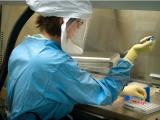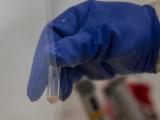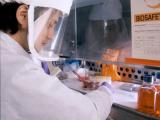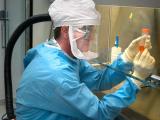Apr 4, 2002 (CIDRAP News) The Texas laboratory worker who recently contracted cutaneous anthrax apparently acquired the lesion by handling poorly cleaned vials of Bacillus anthracis isolates without wearing gloves, according to the Centers for Disease Control and Prevention (CDC).
The worker had not been vaccinated against anthrax, and the vials had not been cleaned with a bleach solution, as recommended by the CDC, according to the report in the Apr 5 issue of Morbidity and Mortality Weekly Report. The lesion developed from a shaving cut the worker had suffered the day before he was exposed to anthrax.
"These particular lab workers were using a solution of basically rubbing alcohol to decontaminate the tops of these vials," said CDC press spokesman Tom Skinner during a telephone press briefing today. The report calls for routine cleaning of lab surfaces and vials with a 10% bleach solution and for vaccination of lab workers who work with B anthracis.
The unidentified lab where the worker was employed had been analyzing environmental samples collected in the investigation of the 2001 anthrax attacks, the report says. The lab is a "provisionally approved Laboratory Response Network level B laboratory."
The worker suffered a cut on the right side of his jaw while shaving on Feb 28, the report relates. The next day, Mar 1, he helped a co-worker move vials containing confirmed B anthracis isolates from a biological safety cabinet in the main laboratory to a freezer in an adjacent room. The worker handled the vials without gloves and then washed his hands with soap and water.
Over the next 2 to 3 days, the man's facial cut grew in size and developed a scab, and he had right cervical adenopathy, a low fever, and swelling and erythema on his right cheek and neck. When he sought medical attention, his provider swabbed the lesion and a vesicle, made a presumptive diagnosis of cutaneous anthrax, and prescribed a 2-week course of ciprofloxacin, the report states.
The swab specimen was cultured at the worker's own lab and at the CDC and tested positive for B anthracis. As a result, the man was hospitalized Mar 5 and treated with intravenous ciprofloxacin and doxycycline. After improving with treatment, he was discharged Mar 9.
An industrial hygienist collected environmental samples Mar 5 at the lab and the worker's home and found B anthracis only on the tops of the vials the worker had handled. The CDC conducted more extensive environmental sampling Mar 7 and found no B anthracis. Investigation of lab procedures revealed that a 10% bleach solution was normally used to clean surfaces after the processing of specimens potentially containing B anthracis. But because bleach caused labels to come off, "storage vials had been sprayed with 70% isopropyl alcohol instead of being wiped with bleach," the report states.
"A vigorous program of routine decontamination with a 10% bleach solution is needed to kill viable B. anthracis spores on laboratory surfaces and vials," the article says. "Alcohol is not sufficient to eliminate viable B. anthracis spores from contaminated surfaces." In addition, workers should wear gloves when handling anything that might contain the microbe and should cover skin defects with "an impenetrable occlusive bandage."
The CDC also says this case demonstrates the need for vaccination of laboratorians who work with B anthracis. "CDC will work with state and local health departments to identify and vaccinate these laboratory workers," the article states.
At today's press briefing officials were asked why the worker hadn't been vaccinated. They replied that anthrax vaccine wasn't readily available at the height of the crisis last fall. Since then the vaccine has become available again, but it remains in limited supply, they said. (BioPort Corp, the sole US maker of anthrax vaccine, obtained Food and Drug Administration clearance in January to begin shipping the vaccine after more than 2 years of delays related to a plant renovation.)
In response to another question, the CDC's Nancy Rosenstein, MD, said, "The efficacy of the vaccine for cutaneous anthrax actually isn't well-known. . . . We expect that the efficacy would be high, and that's why we're recommending that lab workers who handle B anthracis routinely be vaccinated."
The MMWR report says the worker's case is classified as suspected rather than confirmed cutaneous anthrax, because "processing of the swab of the lesion at the same laboratory where the suspected exposure occurred introduces the possibility of contamination of the patient's sample with B anthracis from the laboratory." But the clinical syndrome and exposure history point to anthrax.
CDC officials today said the worker is doing well but still taking oral antibiotics, and the lab continues to operate.
CDC. Suspected cutaneous anthrax in a laboratory workerTexas, 2002. MMWR 2002(Apr 5);51(13):279-81
Full text
See also:
Transcript of CDC telephone briefing dealing with the case of cutaneous anthrax




















